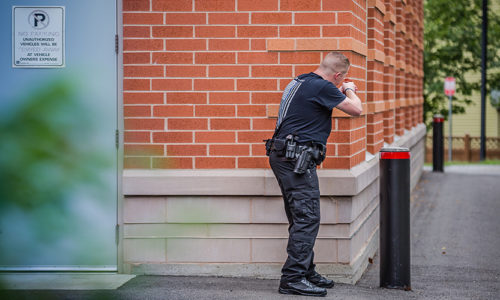

Rigby Middle School Shooting
7 Lessons Learned and 29 Recommendations for Improved Emergency Response.
As seen in Campus Security Magazine:
RIGBY, Idaho — On May 6, 2021, a sixth-grader entered Rigby Middle School, pulled a handgun from her backpack, and started shooting. Two students and one adult were shot before a teacher was able to disarm the student and detain her until police arrived.
During and after the attack, students were evacuated to a nearby high school where parents and guardians were able to pick them up. All of the victims suffered non-life-threatening injuries.
<– Related: Tabletop Exercise 7: Armed Robber Barricaded in Home Adjacent to School
Under the statutory mandate of the Idaho School Safety and Security program (ISSS), an after-action review of the incident was conducted. An analyst from ISSS responded to the scene within a few hours of the shooting to conduct the review. Additional staff arrived on-site later that evening following the conclusion of initial response actions.
From May 7-10, school staff assisted with recovery planning and the execution of those efforts were conducted from May 10-14. Additional intermittent coordination and support was provided through the end of the school year, according to the report.
After the school year ended, the office manager and an analyst unaffiliated with the response efforts interviewed key staff and community responders to discuss lessons learned.
The interviews were conducted from June 1-4 and follow-up interviews were conducted from August 9-10.
Overall, the review determined the response by the school demonstrated the effectiveness of a planned, coordinated, trained and exercised emergency operations plan. Much of what the Jefferson County School District (JCSD) had in place for its emergency response protocols is praiseworthy. However, lessons can always be learned and there is always something that can be tweaked to improve response to future incidents.
The lengthy and thorough after-action report includes seven lessons learned and 29 subsequent recommendations for improved emergency response. The recommendations can be applied to nearly all schools. Many of the recommendations were made based on how well the school and surrounding agencies responded to the shooting while others were made to emphasize where improvements are needed.
The full after-action report can be found here but below are a summary of the findings.
Lesson 1:
Preventing acts of targeted violence within K-12 schools requires means and methods for gathering information of concern, evaluating that information, and developing mitigation strategies based on the assessment of the behavior.
In this particular incident, staff and other adults reported that students had knowledge of concerning behaviors prior to the incident which were not reported until after the shooting. One of the accused shooter’s classmates saw a drawing that depicted a gun and a school and several other students saw concerning social media posts.
Additional students observed changes in the student’s behavior, including changes in appearance, affect and social engagement. In this case, these changes coincided with the transition from elementary to middle school, so the change in behavior was not apparent to Rigby staff as it was the student’s first year. This information also came to light after the shooting during post-incident interviews.
The school did have a tip line available at the time of the incident but it was not stressed to students during the 2021-2021 school year.
Subsequent Recommendations
1: Schools should implement confidential tip lines. Sustainable efforts must be made to ensure that every year, students are educated on and reminded of the use of and importance of the tool.
2: It is recommended that the state of Idaho consider implementing a social media threat detection system for schools in conjunction with police. Attackers often use social media to communicate their intentions prior to a planned attack.
3: Once information on a threat is gathered, a trained multi-disciplinary threat assessment team should evaluate the threat. While JCSD did receive training on behavioral threat assessment team development and possessed an operational framework for threat assessment, evaluation, and management, a threat assessment was not conducted because there were no concerning behaviors reported to staff.
Lesson 2:
The after-action review determined JCSD and local law enforcement have a strong and historic commitment to the school resource officer (SRO) program which proved beneficial on the day of the shooting. Many first responding officers had previously served as SROs within the district and were familiar with district operations and school emergency plans.
SROs also helped to train staff and develop site-specific operations plans as well as conducted an exercise program for staff and students. As a result, the response by students and staff on the day of the shooting was well-coordinated and built on a strong foundation.
In addition to SROs, the district also had in place a formal reserve deputy program where school staff are cross-trained to local law enforcement agency standards. SROs are primarily law enforcement officers within the school but Joint Reserve Deputies are primarily school employees with certified law enforcement standards and training. During the shooting, reserve deputies were not in the immediate area of the attack but were able to respond quickly to assist with response coordination.
Subsequent Recommendations
1: All schools should coordinate with local emergency responders in the development and practice of school safety plans. This can take place in a community safety committee, through the development of an SRO program, or through reserve deputy programs.
2: States should explore strategies to increase training and support for SRO partnerships.
Related: Tabletop Exercise 9: Anonymous Tip Says Student Plans to Bring Weapon to School

Lesson 3:
Uniformly trained and exercised emergency response procedures result in fewer casualties during acts of targeted violence.
For many years prior to the incident, JCSD incorporated a standardized response protocol that was uniformly adopted, trained, and exercised. The response protocol adopted by the district preceded the development of the Idaho Standard Command Responses for Schools (ISCRS) protocol for the state of Idaho, but it incorporated many critical elements of effective response.
The response protocol adopted by the district allowed for some level of individual autonomy of response based on the immediate circumstances. Staff was expected to make the best decision for student safety when it came to lockdown or evacuation during the attack. Once lockdown procedures were initiated, students who were already outside did not reenter, and most classrooms were secured and students remained in place until the scene was under control.
However, one class was evacuated from a securable classroom. When exiting the building, the fleeing students were fired upon by the attacker who had also moved outside.
Subsequent Recommendations
1: SSchools should use standardized protocols, language, training and exercise for their emergency operations plans. For Idaho schools, this is offered through the ISSS program.
2: When staff is trained on options-based response for emergency situations, training must include situational awareness and tactical decision-making.
3: All schools should develop an exercise schedule to practice and evaluate lockdown procedures at least annually in coordination with local first responders. Lockdown training and exercises within JCSD had been in place for many years and its ongoing maintenance substantially increased the effectiveness of the response during the incident.
More info at: campussafetymagazine
Related Articles
Retrofitting Workplace Environments with Advanced Ballistic Protection
How Bullet-Resistant Wall Panels Protect Your Employees and Business deal for retrofitting workplace environments, bullet resistant (BR) wall panels are advanced ballistic protection materials hidden inside walls that help stop bullets and protect building occupants....
Home Holiday Safety Tips
Every year, the holiday season brings families and friends together to celebrate with joyful holiday cheer but, unfortunately, it also brings increased crime rates. According to the National Crime Victimization Survey (NCVS),...
Ballistic Mobile Safe Shield: Your Mobile Defense Solution
Unparalleled Bullet Resistance At SafeWood Designs, we are proud to introduce our newest product, the ballistic Mobile Safe Shield. Designed to provide enhanced security, this innovative solution offers complete customization to suit any environment. From frame paint...
